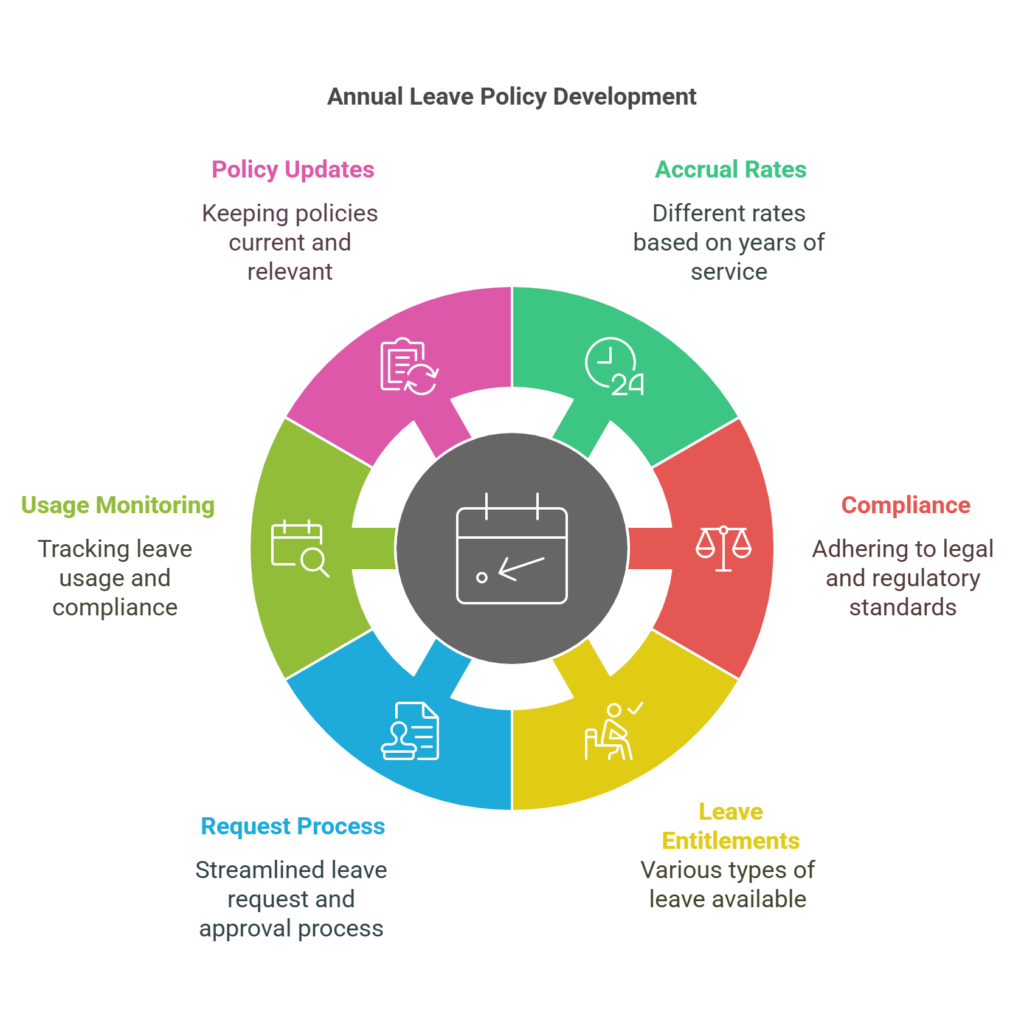In the realm of labor regulations in Saudi Arabia, the concept of annual leave emerges as a pivotal element under the purview of the Saudi Labor Law. This intricate framework mandates that employees are bestowed with specific intervals of paid leave to embrace repose and revitalization. The dynamic nature of this provision allows employers the latitude to orchestrate these periods of respite in alignment with operational exigencies or cyclic work patterns. Moreover, with a requisite lead time of at least 30 days, employees can strategically chart their temporal hiatus.
In this article you can learn about what is annual leave UAE. Also, how calculate it and some other policy and its durations.
What is annual leave in Saudi Arabia?

Within the intricate tapestry of Saudi Arabian labor regulations, the notion of annual leave emerges as a cornerstone, intricately woven into the fabric of the Saudi Labor Law. This pivotal provision bestows upon employees’ crucial intervals of paid leave, serving as a sanctuary for rest and revitalization.
Initially, employees with one to five years of service find themselves graced with a modest allocation of 21 days for annual leave. However, as the sands of time flow and dedication solidifies over five years, this temporal respite blossoms into a bountiful 30-day sojourn.
The orchestration of these leaves lies within the purview of employers. Who must navigate work exigencies and cyclic patterns to ensure operational harmony.
Thus, it becomes paramount for both custodians of commerce and the workforce to not merely skim but delve deep into these regulations. Embracing them as guiding stars to steer the ship of fairness and compliance through the turbulent seas of the modern workplace.
Benefits of encouraging employees to take annual leave in KSA
In the realm of Saudi Arabian workplaces, the advocacy for employees to embrace annual leave unfurls a tapestry of benefits. That intertwine the threads of individual well-being and organizational prosperity.
The act of taking leave provides a sanctuary for employees to pause, rejuvenate, and prioritize their health. Culminating in a holistic enhancement of their overall well-being and a swifter convalescence from ailments or injuries.
Furthermore, the promotion of annual leave acts as a shield against the propagation of illnesses within the workplace. Bolstering productivity and morale by ensuring that unwell employees recuperate at home.
Commending and commemorating employees who embark on their leave not only acknowledges their commitment. But also underscores the profound influence of time off on both personal welfare and organizational triumph.
Ultimately, the advocacy for annual leave weaves a tapestry of trust and allegiance between employers and employees. Fostering a harmonious work milieu conducive to sustained evolution and triumph.
How is Annual Leave Calculated?
How to apply annual leave? How to request annual leave by email? How to write annual leave?
In the intricate labyrinth of Saudi Arabian labor regulations, the calculation of annual leave emerges as a pivotal juncture governed by the Saudi Labor Law.
- This calculation unfurls a dynamic tapestry where employees are granted a foundational 21 days of annual leave. A temporal oasis that blossoms into a lavish 30-day retreat after five years of steadfast service to a singular employer.
- The calculus of this leave entitlement typically hinges on the employee’s actual salary, encompassing all supplementary allowances such as transportation benefits. Employers wield the authority to orchestrate the timing of these leaves.
While employees retain the option to defer their annual respite to the subsequent year with the employer’s blessing.
- Moreover, should an employee depart their employment without availing themselves of accrued leave. They hold the right to claim remuneration for this untapped temporal treasure trove.
- This intricate dance of calculation and entitlement weaves a complex web within the realm of labor dynamics. Underscoring the interplay between regulation, tenure, and remuneration in shaping the annual leave landscape in Saudi Arabia.
HR best practices when developing an annual leave policy

As the journey commences, the beacon of clear communication illuminates the path, guiding organizations to establish employment contracts that serve as beacons of transparency and comprehension for employees.
Encouragement and unwavering support emerge as stalwart companions on this odyssey, urging employees to embark on their annual leave request by extolling the virtues of respite on health, well-being, productivity, and job satisfaction.
Leading by example, managers step into the limelight, showcasing through their actions the profound significance of embracing time off within the organizational ethos. The quest for policy clarity beckons, urging organizations to craft documents that serve as navigational charts replete with information on entitlements, request processes, and the boundaries that delineate the realm of leave.
A chorus of recognition and celebration resounds through the halls, honoring those who heed the call of annual leave application and highlighting the transformative power of temporal reprieve. Moreover, the cadence of regular communication reverberates, underscoring the melody of benefits that annual leave bestows upon individuals and organizations alike.
In the realm of planning and scheduling, a dance unfolds as employees orchestrate their leave in harmony with personal needs and operational exigencies to ensure a seamless transition. Offering a helping hand, organizations extend resources and guidance to aid employees in navigating the ebb and flow of workloads before and after their sojourns.
Moreover, through this display of strategies interwoven with transition words, organizations can embark on a transformative journey towards crafting an annual leave policy that harmonizes employee well-being with organizational prosperity in a symphony of success.
Determine the accrual rate and maximum carryover
In the intricate tapestry of employee benefits, the accrual rate and maximum carryover stand as pillars. Influenced by the passage of time and dedication within the workforce. Delving into the realm of full-time classified employees unveils a dynamic landscape where the accrual rate and maximum carryover evolve in tandem with years of service.
- For those in the nascent stages of their tenure, under 5 years of service, an accrual rate of 4 hours per pay period sets the foundation. With a maximum carryover of 192 hours (24 days) awaiting their stewardship.
- Transitioning into the realm of 5-9 years of service, employees witness a shift to an accrual rate of 5 hours per pay period. Accompanied by a maximum carryover expanding to 240 hours (30 days).
- As the journey progresses into the realm of 10-14 years of service, a new chapter unfolds. With an accrual rate of 6 hours per pay period beckoning, alongside a maximum carryover burgeoning to 288 hours (36 days).
- The narrative continues to unfold for those in the realm of 15-19 years of service, where an accrual rate of 7 hours per pay period emerges. Leading to a maximum carryover swelling to 336 hours (42 days).
- Stepping into the domain of 20-24 years of service, employees encounter an accrual rate escalation to 8 hours per pay period. Ushering in a maximum carryover expansion to 384 hours (48 days).
- Finally, for stalwarts with 25 years or more of service, an accrual rate crescendo to 9 hours per pay period awaits. Accompanied by a maximum carryover soaring to 432 hours (54 days). Symbolizing a culmination of dedication and tenure in the realm of accrued leave.
Ensure compliance with applicable laws and regulations
Within this dynamic and ever-shifting landscape, the orchestration of regulatory compliance management unfolds: As a symphonic opus of meticulously crafted measures. Also, policies, and processes intricately woven to meet the ceaselessly evolving legal mandates. Also, regulatory imperatives that shape the intricate tapestry of compliance.
Compliance stands as an indomitable fortress safeguarding consumers, preserving the sterling reputation of businesses. Also, shielding venerable senior management and leadership from the looming specter of potential criminal liability.
Thus, organizations are compelled to unfurl the grand standard of a robust regulatory compliance policy as an emblematic testament. To their unyielding commitment to upholding the sanctity of the law and navigating the turbulent seas of legal conformity.
Multinational entities embark on a perilous odyssey through diverse regulatory terrains in each country they traverse. Meticulously ensuring alignment with local laws such as GDPR in the EU.
In this intricate tap of compliance and regulation, organizations must deftly weave a tapestry interlaced with policies. Also, practices that not only adhere to industry-specific mandates but also deftly navigate the labyrinthine pathways of global regulatory environments. With finesse, precision, and an unwavering commitment to legal integrity.
Consider various leave entitlements
The sources provide comprehensive information on various leave entitlements in different contexts. While they delve into annual leave entitlement in Singapore under the Employment Act. They also discuss common types of leave entitlements like vacation, personal days, and sick days.
Additionally, the sources outline the basic leave entitlement under the Family and Medical Leave Act (FMLA) and explore the diverse range of leave options available at the University of Alaska. However, there is no specific information available in the provided sources regarding leave entitlements in the UAE.
If you need information on this topic, I recommend conducting a targeted search focusing on labor laws. Also, regulations in the United Arab Emirates to gather relevant details about leave entitlements specific to the UAE.
Establish a clear process for requesting and approving annual leave
Establishing a streamlined process for annual leave involves employees submitting requests adhering to set procedures. Subsequently, employers promptly review and communicate approval decisions clearly. Calculating entitlements based on service length and accrued days is crucial, considering factors like public holidays.
Moreover, accurate record-keeping ensures transparency and compliance. Clear guidelines on notice periods aid effective leave planning. Additionally, flexibility in approvals balances operational needs with employee satisfaction.
Furthermore, effective communication of policies is vital for understanding rights and responsibilities. By implementing these steps diligently and fostering a harmonious work environment, organizations can manage annual leave efficiently. Ensuring compliance and enhancing employee well-being.
Monitor usage and compliance
In the realm of monitoring annual leave usage and compliance, leveraging tools like Leave Monitor and Annual Leave is pivotal.
- Firstly, these platforms streamline managing absences, tracking various leave types, and ensuring labor law adherence.
- Secondly, monitoring employee annual leave allowance encourages timely utilization, preventing excessive balances. This proactive approach promotes work-life balance, reduces stress, and yields cost savings.
- Additionally, effective monitoring maintains staffing levels, boosts productivity, and fosters a positive work environment.
By utilizing these tools adeptly, organizations enhance operational efficiency. Mitigate leave accumulation risks, and nurture a culture of well-being and compliance.
Ensure policy remains up to date
To ensure that policies remain up to date, organizations can implement several key strategies outlined in the provided sources.
- Firstly, involving leadership in the policy creation process is crucial to ensure that policies are feasible. For different departments and are clearly understood by employees.
- Secondly, determining the best format for policies based on the audience’s preferences and needs can enhance compliance and understanding.
- Additionally, making policies easily accessible to employees by structuring them logically. Also, using multiple communication channels like email, intranet, and meetings is essential.
- Moreover, regularly reviewing policies, involving stakeholders in the update process. Also, utilizing technology solutions for policy management can streamline the process and maintain compliance with evolving regulations.
By following these steps diligently, organizations can effectively keep their policies current and aligned with changing requirements.
How Long After Starting a Job Can Employees Take Leave?
In the intricate realm of employment dynamics, the question of when employees can embark on taking leave after commencing a new job emerges as a labyrinthine conundrum.
- While conventional wisdom suggests a prudent waiting period of a few months before delving into vacation days. Especially if accrued time off is not yet available, nuances and exceptions abound. Some sources hint at the possibility of preplanned vacations predating the job start date, adding a layer of complexity to the equation.
- Factors like workload demands, team interdependencies, and the nebulous realm of company culture further complicate the decision-making process surrounding the timing of leave uptake.
Navigating this perplexing terrain requires a delicate balance between adhering to company policies. Also, considering individual circumstances with finesse and strategic acumen.
Are workers paid during annual leave?
Indeed, workers are usually paid during annual leave. Annual leave is a period of approved absence with pay from official duties, intended to allow employees vacation, rest, and recreation.
Additionally, during the period of annual leave, employees are in pay status, and they continue to accrue annual and sick leave. Consequently, employees receive their regular pay while on annual leave, ensuring that they are compensated for their time off.
Final Thoughts
A comprehensive framework emerges to ensure employees are granted essential time off for diverse reasons such as vacation, sickness, maternity, and unique circumstances like Hajj.
The entitlement to annual leave varies based on service length. Typically offering 21 days for tenures under 5 years and extending to 30 days for longer periods. Employers wield the authority to dictate leave timing, with provisions for postponement under specific conditions.

Moreover, employees enjoy a spectrum of leave types including sick leave, maternity leave, paternity leave. Also, compassionate leave, each delineated by precise guidelines and entitlements. Ultimately, Saudi labor laws prioritize employee well-being through a structured leave system fostering a harmonious work-life balance. Contact us to learn more.

